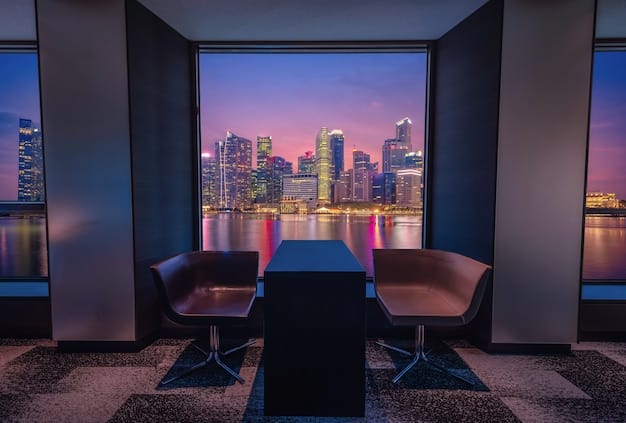The Sound Design Secrets That Made “Succession’s” Finale So Immersive

The sound design of “Succession’s” finale played a pivotal role in heightening the emotional tension and realism, utilizing subtle soundscapes and strategic silences to create an immersive and unforgettable viewing experience.
Ever wondered how the finale of “Succession” gripped you so tightly? Dive in as we reveal the sound design secrets that made “Succession’s” finale so immersive, turning up the emotional volume and leaving viewers in stunned silence.
Crafting Authenticity: The Role of Sound Design
Sound design is often an unsung hero in television, but it plays a critical role in shaping our perception of a story. It’s not just about adding effects; it’s about creating an environment that feels real and draws the viewer deeper into the narrative. Sound design can subtly manipulate emotions and set the atmosphere, a factor extremely relevant when looking at the immersive world of “Succession”.
In the context of a show like “Succession”, where power dynamics and emotional nuances are paramount, sound design becomes an even more essential tool. It helps to accentuate tension, highlight character traits, and underscore pivotal moments. The absence of sound can sometimes be just as powerful as its presence, creating a sense of unease or anticipation.

The Art of Subtlety
Subtlety is key in effective sound design. The best sound work often goes unnoticed because it blends seamlessly into the scene, enhancing the viewer’s experience without drawing attention to itself. It’s about creating a rich, layered soundscape that feels natural and authentic.
- Environmental Sounds: Realistic ambient noises that place the scene in a specific location.
- Foley Artistry: The creation of everyday sounds in a studio, synced to the action on screen.
- Strategic Silence: Using silence to emphasize dramatic moments or create tension.
The sound design in “Succession’s” finale elevates moments of tension and intimacy through subtle auditory cues, enriching the audience’s connection to the drama and realism.
“Succession’s” Sonic Palette: Key Elements
“Succession” carefully uses various elements to build its sound design, contributing to the immersive and impactful atmosphere of the show, especially in the final episode. These elements help to draw viewers into the world of the Roys, making the drama feel palpable and immediate.
From the subtle hum of corporate offices to the echoing silence of opulent estates, every sound is meticulously crafted to enhance the narrative. The show’s sound designers masterfully blend these elements to create a sonic landscape that is both realistic and emotionally resonant. This is particularly evident in the finale, where every sound choice amplifies the stakes and deepens the emotional impact.
Elevating Tension Through Audio
One of the defining characteristics of “Succession” is its ability to create and sustain tension. Sound design plays a crucial role in this, using a variety of techniques to keep viewers on the edge of their seats.
- Low-Frequency Rumbles: Subsonic sounds that create a sense of unease and impending doom.
- Sudden Sound Bursts: Unexpected loud noises that jolt the viewer and heighten anxiety.
- Increasing Tempo: Gradually speeding up the pace of background sounds to build suspense.
In “Succession’s” finale, the heightened tension through audio techniques amplifies the uncertainty and drama, keeping viewers emotionally invested.
Silence as a Weapon: Strategic Use of Quiet
In the realm of sound design, silence can be just as powerful as sound. Strategic use of quiet can create a sense of unease, anticipation, or profound emotional impact. It’s a tool that “Succession” wields with remarkable precision, understanding the dramatic weight that silence can carry. The absence of noise highlights the gravity of moments.
The use of silence is a strategic tool to amplify emotional impact by emphasizing tension and uncertainty. By carefully removing environmental sounds or dialogue, the designers draw viewers deeper into the characters’ internal worlds, allowing them to viscerally experience the weight of their decisions and emotions.
Moments of Quiet Reflection
Silence is particularly effective in moments of reflection or when a character is grappling with a difficult decision. The absence of external noise allows the viewer to focus on the character’s internal state, deepening their emotional connection.
Moments where “Succession” leverages silence as a narrative device include:
- The Aftermath of Conflict: Quiet scenes following intense arguments or confrontations.
- Personal Realizations: Solitary moments where characters come to important realizations.
- Standoffs: Prolonged silences that build tension during critical negotiations or power plays.
Strategic silences throughout the episode accentuate the actors’ performances and magnify the impact of critical plot points.
Sound Design and Character Development
Sound design isn’t just about creating an immersive world; it’s also a powerful tool for character development. Subtle auditory cues can reveal aspects of a character’s personality, background, or emotional state. The skilled sound designers in “Succession” utilize these cues to add depth and complexity to the show’s ensemble cast.
By associating specific sounds or musical motifs with certain characters, the sound designers create a sonic shorthand that enhances our understanding of their personalities and motivations. These auditory cues can be subtle, but they contribute to the overall richness and complexity of the characters. This technique is used consistently throughout the series.
Auditory Cues for Character
Each character had unique sound design associated to them to emphasize character development.
- Logan Roy: The imposing presence of Logan was often emphasized by deep, rumbling sounds and the echo of his footsteps.
- Kendall Roy: Kendall’s internal struggles were often amplified by dissonant music and fragmented soundscapes.
- Shiv Roy: Shiv’s sharp, calculated demeanor was often reflected in crisp, clean sound design and the click of her heels on hard surfaces.
The sound design choices associated with each character are effective ways to subtly reinforce the traits while deepening the viewers understanding of them.
Music as Narrative: The Score’s Impact
The musical score of “Succession” is more than just background music; it’s an integral part of the show’s storytelling. Composer Nicholas Britell’s distinctive score captures the essence of the show’s themes, from power and wealth to family dysfunction and emotional turmoil. The score is often used to foreshadow events, underscore emotional beats, and heighten the overall sense of drama.
Britell’s compositions are characterized by their use of classical instruments, such as piano and strings, combined with modern electronic elements. This fusion creates a sound that is both timeless and contemporary, reflecting the show’s blend of old money and modern ambition. Music subtly manipulates emotions and enhances tension and anticipation.
Key Musical Themes
The themes in “Succession” go hand-in-hand with the music behind them.
- Main Theme: The show’s iconic opening theme is a haunting, piano-driven piece that immediately establishes the tone of opulence and decay.
- Character Motifs: Specific characters are often associated with recurring musical motifs that evolve and transform along with their storylines.
- Emotional Underscoring: The score is used to amplify the emotions of key scenes, from moments of triumph to devastating betrayals.
The overall impact of the musical score in “Succession” adds depth and complexity, seamlessly interweaving with the narrative to amplify emotional resonance, making it an integral aspect of the show.
Technical Excellence: Production Secrets
The seamless and immersive sound design of “Succession’s” finale is a testament to the technical expertise of the show’s production team. From the initial sound recording to the final mixing and mastering, every step of the process is executed with meticulous attention to detail.
The team utilizes state-of-the-art equipment and techniques to capture and manipulate sound, creating a sonic landscape that is both realistic and emotionally resonant. The show’s commitment to technical excellence is evident in the final product, which sets a high standard for sound design in television.
Behind-the-Scenes Techniques
The excellence of the technical side of “Succession” is due to several techniques.
- Location Recording: Capturing pristine audio on location, often in challenging environments.
- ADR (Automated Dialogue Replacement): Re-recording dialogue in a controlled studio setting to improve clarity and performance.
- Mixing and Mastering: Expertly blending and balancing the various sound elements to create a cohesive and immersive listening experience.
Technical prowess in sound design enhances storytelling, making every episode of “Succession” a masterclass in audio production, immersing viewers completely in its world.
| Key Aspect | Brief Description |
|---|---|
| 🔊 Authentic Soundscapes | Crafting realistic soundscapes that enhance the narrative’s realism. |
| 🤫 Strategic Silence | Using quiet moments to amplify tension and draw viewers into characters’ emotions. |
| 🎶 Narrative Music | Employing musical themes to underscore emotional beats and foreshadow events. |
| 🎧 Technical Excellence | Utilizing state-of-the-art techniques to ensure high-quality audio production. |
Frequently Asked Questions
▼
Sound design in “Succession” enhances tension, character depth, and emotional impact. It creates an immersive experience, making the drama feel more real and engaging for viewers.
▼
“Succession” strategically uses silence to amplify tension and emotional weight. Quiet moments draw viewers into the characters’ internal worlds, highlighting the gravity of their decisions.
▼
The music in “Succession”, composed by Nicholas Britell, underscores emotional beats and foreshadows events. It combines classical instruments with modern electronic elements, enhancing the drama.
▼
Specific auditory cues emphasized the character of Logan Roy with deep, rumbling sounds; Kendall Roy with dissonant music and fragmented soundscapes; and Shiv Roy highlighting sleek, clean sound design.
▼
Behind-the-scenes, the show captures pristine location audio, utilizes ADR for dialogue clarity, and relies on expert mixing and mastering to create an immersive listening experience for viewers.
Conclusion
The intricate and thoughtful sound design secrets that made “Succession’s” finale so immersive showcases how crucial audio is to storytelling; where silence and specific soundscapes create depth, tension, and emotional resonance, making a lasting impact.
![Illuminate Emotions: Lighting Techniques in [Show Title]'s Finale Illuminate Emotions: Lighting Techniques in [Show Title]'s Finale - Cover Image](https://endingnew.com/wp-content/uploads/2025/06/endingnew.com_13_1749558998_8e435348_cover-360x180.jpg)


![The Music Behind the Magic: Unpacking the [Movie Title] Score The Music Behind the Magic: Unpacking the [Movie Title] Score - Cover Image](https://endingnew.com/wp-content/uploads/2025/06/endingnew.com_13_1749558769_5379e62d_cover-360x180.jpg)
![Unveiling the Secrets: Costume Design in [Show Title]'s Finale Unveiling the Secrets: Costume Design in [Show Title]'s Finale - Cover Image](https://endingnew.com/wp-content/uploads/2025/06/endingnew.com_13_1749558836_c21c77d2_cover-360x180.jpg)
